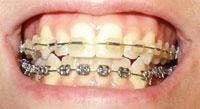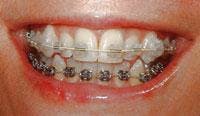Adult Orthodontics
by Jeri Starrett, RDH, BS
As far back as the time of Hippocrates, 400 BC, humans have been attempting to straighten teeth, according to Dr. Michael Rennert of Montreal, past president of AAO. During archeological excavations, mummies have been uncovered with metal bands around their teeth. Researchers theorize that in ancient times, catgut was used in an attempt to close spaces between the teeth1.
Now fast forward to today. More than one million adults over the age of 18 are undergoing dental orthodontic treatment due to advances in technology and dental materials. Treatment procedures are much more comfortable than earlier times. One of the most significant recent developments is the heat-activated nickel-titanium alloy wires created by NASA. Activated by body heat, the wires become more flexible and utilize gentle pressure to gradually move the teeth in the desired direction. The use of the nickel-titanium wire increases the length of time patients can go between appointments and there is less discomfort due to the gentle pressure that is applied with the high tech wire.
Today's orthodontic appliances are smaller and less visible. Brackets are available in a range of color options, including clear, tooth colored, gold and silver. Elastic bands that secure arch wires to the brackets are stain resistant and orthodontic wires now come with a tooth-colored coating as well as silver wire.
Treatment options, in addition to traditional orthodontic brackets, include lingual braces or removable aligners. Invisalign® utilizes custom-made, removable aligners. Each set of aligners are worn 22 hours per day for approximately two weeks as the teeth gradually move. The aligners are removed when eating, or brushing and flossing the teeth.
Adults seek orthodontic treatment for a variety of reasons. The primary motivation is the desire to improve their dental appearance. Many adults come for treatment of overcrowding, malocclusion, or diastemas. Pain or discomfort due to temperomandibular joint problems can be the impetus for patients to consult an orthodontist, or a general dentist who provides orthodontics services. Adults going through restorative treatment or periodontal therapy may require orthodontic intervention to properly align the teeth as part of the treatment process.
Two types of orthodontic treatment are available. Adjunctive orthodontic treatment is the movement of teeth to improve occlusion to facilitate other dental procedures needed to control disease and restore function.2 Adjunctive treatment includes extrusion, molar uprighting, space redistribution and incisor alignment.3
Examples of adjunctive treatment include realignment of the teeth adjacent to a missing tooth to ensure adequate space for an implant, or uprighting a tipped molar to improve access for oral hygiene to prevent periodontal pocket formation. Treatment time is typically short and often involves only a portion of the arch. Often, the general dentist completes adjunctive treatment.
Comprehensive orthodontic treatment is the process that corrects the malocclusion. The objectives are to restore occlusal relationships, provide for long term tooth-bone stability and balance dental-facial esthetics.3 With the goal of achieving ideal occlusion, comprehensive treatment involves correcting open bite, deep bite, Class II or III malocclusions and skeletal deficiency or excess. The treatment phase is 18 months or longer. Fixed appliances are utilized to move the teeth and treatment involves the entire arch or both arches. An orthodontist is the provider of choice for comprehensive orthodontic treatment.
Adult treatment differs from treating children or adolescents. Periodontal disease is a major concern and must be under control prior to the start of comprehensive treatment. Adherence to a strict oral hygiene program and regular dental preventive maintenance while undergoing treatment are critical to optimal oral health. Gingivitis and gingival enlargement are typical tissue responses due to the placement of orthodontic appliances. A thorough plaque removal regimen is essential and will promote healthier gingival tissues. Mechanical aids including floss, interdental brushes, floss threaders, oral irrigators and powered toothbrushes are beneficial to adult orthodontic patients.
Orthodontists are often able to correct cranial and facial growth problems in children by utilizing orthopedic, growth-modifying appliances. For adult patients, orthognathic surgery may be required to correct skeletal discrepancies. Missing teeth and teeth that are damaged or have excessive wear add to the challenges of orthodontic treatment in adults.1
Concern regarding social acceptance associated with wearing orthodontic appliances is the main barrier preventing adults from seeking orthodontic treatment.3 As more adults enter treatment, this is becoming less of an issue. Additional barriers to treatment are cost, length of treatment and concern that the process with be uncomfortable. Many adults are not aware that orthodontic treatment could be an option for them or that insurance benefits are available.
Numerous studies confirm that adults who undergo orthodontic therapy are very pleased with the result. Braces can be an option at any age as illustrated by Maria Castro who, at age 91, completed orthodontic treatment. Over the course of several years one of her teeth changed position.1 Her family dentist along with her son, an oral surgeon, suggested she get braces given her healthy periodontal status. Fortunately for Maria, her dentist realized the importance of restoring her smile.
Encourage your patients to consider orthodontics and provide them with information on the options available to them. By sharing with your patients the significant advances in orthodontics, you will be helping them maintain a smile for a lifetime.
Jeri Starrett, RDH, BS, is the Associate Manager of professional relations at Philips Oral Healthcare, Inc. She can be contacted at [email protected].
References1 American Association of Orthodontists. Orthodontic History. Available at: "http://www.braces.org/history//" Accessed June 6, 2003.
2 Ong, M., Wang, H. Periodontic and orthodontic treatment in adults. Am J Orthod Dentofacial Orthop 2002;122:420-428.
3 Buttke, T., Profit, W. Referring Adult Patients for Orthodontic Treatment. JADA 1999:Vol. 130:73-79.
4 Photos reprinted courtesy of www.archwired.com.



